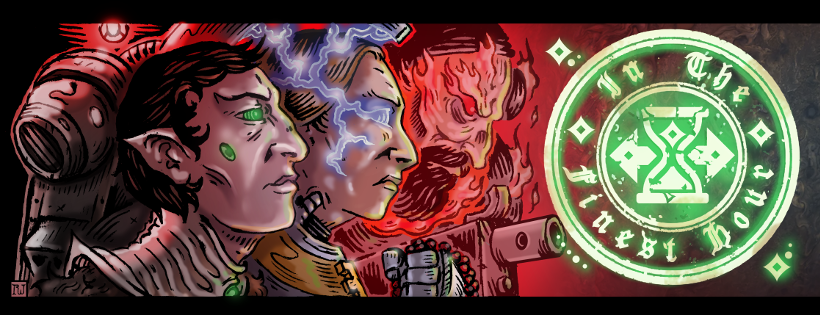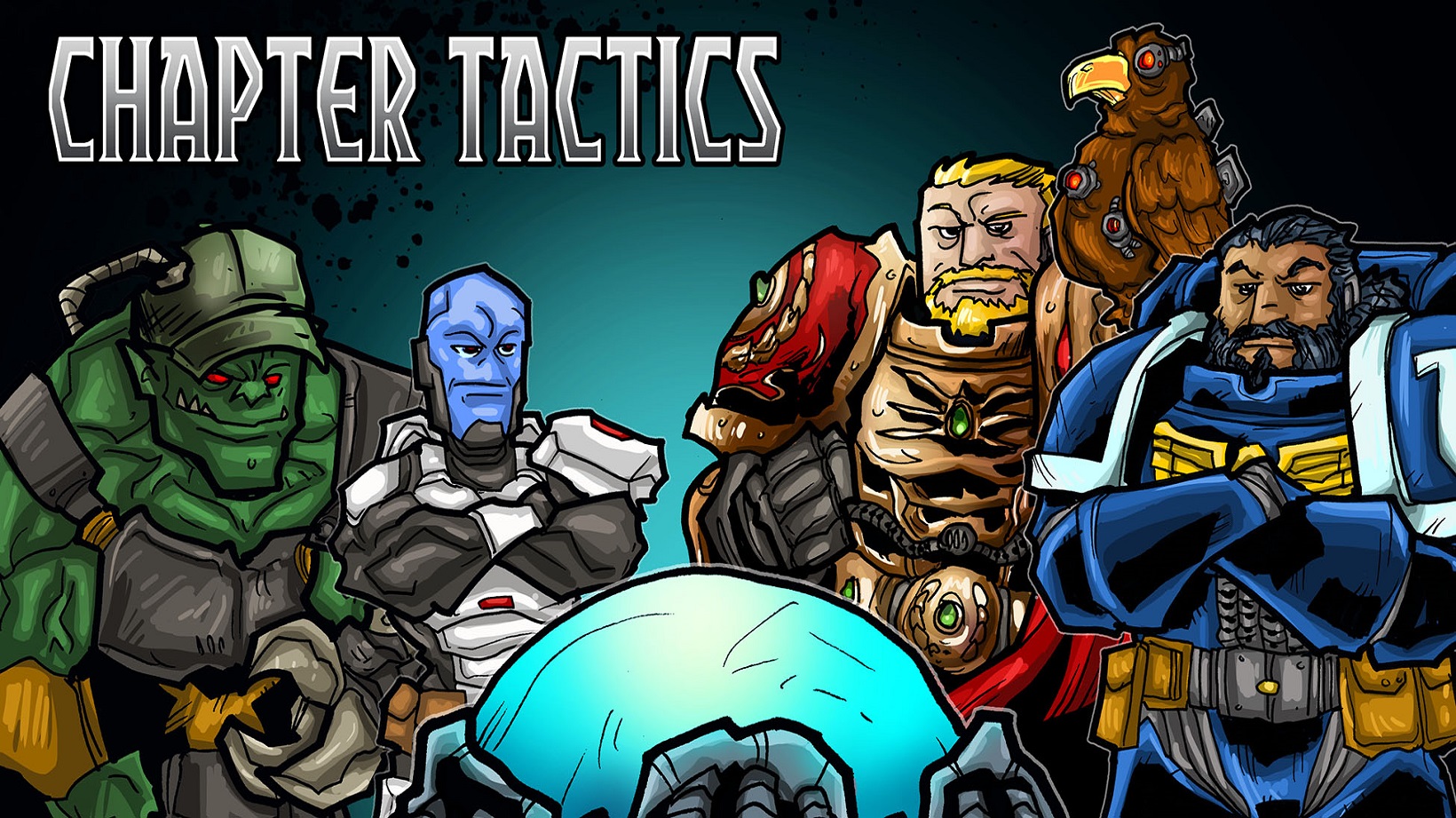Today Pablo, Sean, Skari and Brandon talk about the roles units play in your 9th edition lists and how to capitalize on their strengths and weaknesses. They also talk about Peteypab’s undefeated RTT list and RAW vs. RAI rulings at events.
Chapter Tactics is a 40k podcast which focuses on promoting better tactical play and situational awareness across all variations of the game.
- Head on over to 40kstats.com for more faction stats for all major ITC tournaments!
- Support us on Patreon this month and get a chance to receive random stuff from us!
- Click here for a link for information on downloading best coast pairings app where you can find lists for most of the events I mention.
- Check out the last episode of Chapter Tactics here. Or, click here for a link to a full archive of all of our episodes.
- Check out Skari on Skaredcast, for excellent 40k tactics videos and Monday Meta analysis.
- Commercial music by: www.bensound.com
- Intro by: Justin Mahar


And remember, Frontline Gaming sells gaming products at a discount, every day in their webcart!





As someone with a lot of influence on tournament rulings here, while not being a TO myself. These are things that I house rule:
1. Where it’s obvious GW missed a word or sentence. Think SW army wide obsec, the Custodes thing and this SM relic, etc. Basically if a word/sentence disappears and the rule changes very substantially without any comment on such a change (and in FAQs if another smaller change happened as well in the same rule change).
2. Where something becomes unplayable. Think 8th ed Assault weapon rule which made assault weapons unshootable, 9th fortification 3″ requirement, Tyranid spore mine thing, that was undeployable, etc
I wouldn’t house rule something like resurrecting ATVs though, because it’s not obvious what GW intended.
Oh and also where stuff becomes really really stupid, eg:
4+ with +1 to save roll needs 4AP to fully penetrate
3+ with +1 to save roll needs 5AP to fully penetrate
2+ with +1 to save roll needs 9999999999999999999999999AP… no wait it’s suddenly impossible!!!
Yeah, fuck that.
Not to save roll, +1 to characteristic. You can modify roll however you want, but once you have sv characteristic of 1+ it becomes unpenetrable, because of other rule that you cannot reduce roll below 1. Ap reduces roll, not save characteristic.
That’s why gw had to Errata problematic sv upgrades to be mostly to roll modifiers instead of characteristic modifier.
The comment is referring to house ruling where the rule as written makes something unplayable or functionally stupid, I don’t think theres a disagreement with why an errata was needed, just pointing out they house ruled it in advance because it was dumb
I’m gonna disagree (for once) with Sean’s slippery slope fallacy in this case.
First of all, GW clearly have enough money to hire a decent rules editor. They clearly chose not to hire said editor. Listening to their interview with Jervis, I was horrified they didn’t have a rules guidelines document until well into 8th. That said, 9th edition has been a welcome change with regards to writing quality and clarity. Their increasingly wordy, yet more intuitive, rules are easier to understand and require less FAQing. They also have the ability to change point costs and update rules throughout the year, they just actively chose to not do that.
While rules that are broken and have unintended consequences on their own due to insanely bad wording, like how you could theoretically make Salamanders units untargettable for a bit in 8th, need a faster response from TOs as the FAQ wasn’t out until after the 2 day tournament I was running. Luckily, it wasn’t a big tournament, so I asked those whom I know played Sallies to avoid using it in an exploitative manner and hopefully avoid the feelsbad moments. They acquiesced and potentially awful experiences were avoided. However, I see how this virtually impossible for many events.
Now, enter things like the UM stratagem CutiePab described, or the Chaplain Dread list of 9th, or the IH lists running 80% win rates. Are these intentional? Because not even God knows when it comes to GW. Even a cursory look revealed their rules were insane, so I would presume they intended it. I’m very hesitant to guess at others’ intentions.
Do I errata the game to tone down a specific build like the LVO winning list? But where do I stop? Should I have errataed rotate ion shields for IK, as in the Castellan build, when Space Wolf Dreadnoughts lost their 3++? Should I have attempted to fix double spear Ynnari? The 80% win rate of IH at the start of their launch, should I have nerfed or banned the SM codex? Some tournaments have rules locked a month out (sans FAQs), but then you’re playing “behind” the meta with potentially old rules. Ad hoc changes can feel arbitrary – “you nerfed my SMs, but you were happy to let us be stomped most of 8th.”
Essentially, how far do I go to fix the most glaring problems of 40k? Should I ban SMs until they are brought within the same power range as the other Factions? Or should I let SMs run roughshod over everyone? If I start banning and errataing rules, what do I do with the next most powerful faction? Do I ban Harlequins, then Necrons?
I’m not trying to be insincere or facetious – it’s a genuine problem. Players will start to feel aggrieved if the game is changed by TO if they feel it’s unfair. I don’t have a good solution.
You are literally describing the Slipper Slope Fallacy there. “If we do Thing X, why would we not do Thing Y and Thing Z and on and on to infinity” is the very definition of that argument. And the response is simple: because we are not obligated to fix all problems and all potential wording issues. A TO is perfectly justified in adjucating an alteration to one wording and not to others, because that is what TOs do.
I feel like the alternative that people are proposing is far more problematic: that every rule should be played literally RAW every time, regardless of what this means for the game. While GW has obviously gotten better about writing rules and fixing problems, things still slip by- as evidenced by this very discussion. I’ll take things back to the Nuclear Pyrovore that I mentioned in the show: would you want to play against that? There was no argument about it, RAW; it deal mortal wounds to every enemy unit on the battlefield, end of story. In my opinion, a rule like that creates a tremendously unfun play experience for the opponent due to a very small and easily-correctable rules error. To argue that no error should ever be corrected, because SOME people disagree about the potential for some rules wordings to be in error, seems like a truly terrible path to take. It cedes a tremendous amount of power over to people who will argue for bizarre and arbitrary rules interpretations and makes misprints and small editing errors into potential game-ruining flaws.
That’s not what a slippery slope fallacy is, though. A slippery slope argument isn’t always a fallacy – it’s only a fallacy when it’s used to assert that two distinct things are equivalent because there is no clear dividing line between them. In this case, simply pointing out that a slippery slope exists between two states (determining which rules that people don’t like are functioning as intended and shouldn’t be changed vs which ones are mistakes or oversights and should be house-ruled) is not a fallacious use of the slippery slope. There is a need to come up with a rule for determining where the dividing line is, and asking whether introducing such a rule will create more problems than it solves is perfectly sound reasoning.
I don’t disagree with your conclusion; I think house-ruling obviously broken rules is the right way to go. It’s just not a slippery slope fallacy.
(Specifically, a fallacious slippery slope argument is typically of the form “A to B is a small step, and B to C is a small step, …, and Y to Z is a small step, therefore once A happens Z will eventually happen also, and Z is very bad, so you shouldn’t do A” – this is a fallacy only in that it asserts that Z is inevitable, if in fact one could stop at any intermediate step. Choosing at what point to stop, however, may be non-trivial and can, at least in principle, create new challenges, particularly in building a consensus around the choice of intermediate step at which to stop – acknowledging that this challenge may arise as a result of A is not fallacious reasoning.)
The fallacious use of the slippery slope is specifically that if you do A, you will _inevitably_ do B, C, D, E, etc, even though there is no automatic connection between them. For example, “if we ban drunk driving then we’ll ban driving while drinking soda next, then all driving of any kind” is a slippery slope argument because there is no reason to assume that one kind of ban will lead to another.
“Do I errata the game to tone down a specific build like the LVO winning list? But where do I stop?”
That’s the slippery slope right there. The existence of a gradation of decisions is not a fallacy- but arguing that a decision erases all nuance and will lead to the extreme result is.
But that’s kinda it – I don’t think it’s a fallacy in this case. Calling it a fallacy doesn’t mean it is a fallacy. That’s just a no u argument. There’s a significant grey area of comping games, be it playing highlander, bans, or erratas.
I’m not arguing that no error should ever be corrected either, so we agree there! It’s just that guessing at GW’s intentions isn’t always cut and dry – take FW and GW playing melta bombs differently in 7th.
It’s normally not a problem, as a single, stand-out broken rule doesn’t slide you far down said metaphorical slope. However, that’s not what I’m talking about. To take exactly what you said:
In my opinion, a rule like that creates a tremendously unfun play experience for the opponent due to a very small and easily-correctable rules error.
There’s lots of rules that create tremendously unfun play experiences, and it seems GW has recently labelled them “Codex Adeptus Astartes.” I’m not trying a bad faith argument here, it’s just that’s not quite as simple as you make it out. The two most recent SM codices have both created “a tremendously unfun play experience for the opponent.” Was this GW’s RAI?
TOs have a certain responsibility to ensure a fun experience for their players (or tournouts will suffer), which is why 7th was such an issue. While extreme, I think banning the SMs’ 2nd 8th edition codex wouldn’t have been a bad idea. Nor do I think banning Ynnari or the Castellan at the time would be too far. But that’s ad hoc and will feel arbitrary to those who genuinely play those lists casually with beautifully painted armies. If GW’s ruleswriting ends up creating an unfun tournament scene, I think TOs should be encouraged to start banning codices/subfactions until GW actually manage to bring about a semblance of balance.
I also don’t want to make this a bigger problem than it is, but there’s a reason some Swedish tournaments, IIRC, have 1 month rules cut offs.
I think Aus used to have a weird comp system a few editions ago to try to alleviate the imbalances of the game, which took them quite far down the slope, creating a different meta in the process.
E.g. the Fellblade suddenly got a carrying capacity of 25 for the first time ever. Is GW changing something now they took over FW’s ruleswriting? Or have they skimped on paying the editor again? Should I as the TO errata that in case someone wants to bring it? Or do I let it lie? It’s not gamebreaking, but a Fellblade with 20 Khorne Berzerkers and supporting characters will potentially create some really unfun experiences for newer tournament attendees, same as untargettable Salamanders and Ynnari getting more activations than anyone else. The rules creating either situation are equally broken, but which do you chose to fix?